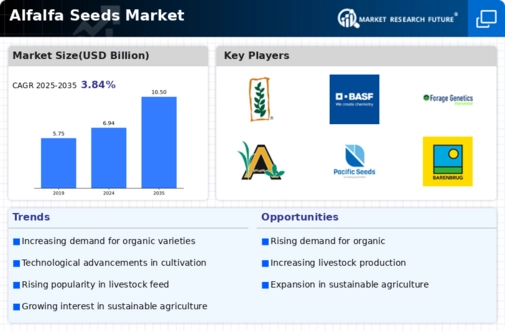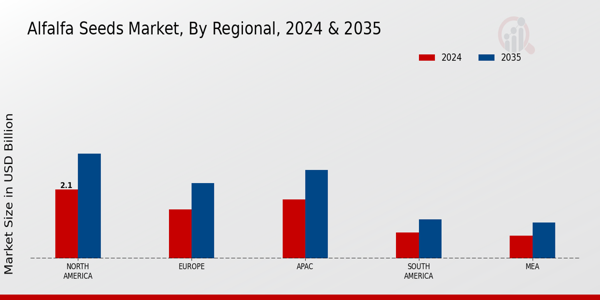Global Trade Dynamics
The Global Alfalfa Seeds Market Industry is significantly impacted by global trade dynamics, particularly in regions where alfalfa is a staple crop. Trade agreements and tariffs can influence the availability and pricing of alfalfa seeds, affecting market stability. Countries that are major producers and exporters of alfalfa seeds play a crucial role in shaping market trends. As international demand fluctuates, the market may experience shifts in pricing and supply. This interconnectedness suggests that the Global Alfalfa Seeds Market will continue to evolve, adapting to the complexities of global trade and economic conditions.
Market Growth Projections
The Global Alfalfa Seeds Market Industry is projected to experience substantial growth over the next decade. With a market valuation of 6.94 USD Billion in 2024, it is anticipated to reach 10.5 USD Billion by 2035. This growth trajectory indicates a CAGR of 3.84% from 2025 to 2035, driven by various factors including increased demand for livestock feed, technological advancements, and a shift towards sustainable agricultural practices. These projections highlight the potential for investment and development within the alfalfa seed sector, as stakeholders seek to capitalize on emerging opportunities in this evolving market.
Rising Demand for Livestock Feed
The Global Alfalfa Seeds Market Industry experiences a notable surge in demand for high-quality livestock feed, driven by the increasing global meat consumption. As populations grow and dietary preferences shift towards protein-rich foods, the need for nutritious feed sources like alfalfa becomes paramount. In 2024, the market is valued at 6.94 USD Billion, reflecting the critical role alfalfa plays in livestock nutrition. This trend is expected to continue, with projections suggesting that by 2035, the market could reach 10.5 USD Billion, indicating a robust growth trajectory fueled by the livestock sector's expansion.
Sustainable Agricultural Practices
The Global Alfalfa Seeds Market Industry is significantly influenced by the growing emphasis on sustainable agricultural practices. Farmers increasingly adopt alfalfa due to its ability to improve soil health and reduce the need for chemical fertilizers. Alfalfa's nitrogen-fixing properties contribute to sustainable farming, aligning with global initiatives aimed at reducing environmental impact. This shift towards eco-friendly practices is likely to enhance the market's appeal, as consumers and producers alike prioritize sustainability. As such, the market is projected to grow at a CAGR of 3.84% from 2025 to 2035, reflecting the increasing adoption of sustainable crops.
Growing Awareness of Nutritional Benefits
The Global Alfalfa Seeds Market Industry benefits from the growing awareness of the nutritional advantages of alfalfa. As consumers become more health-conscious, the demand for alfalfa as a dietary supplement and health food ingredient rises. Alfalfa is rich in vitamins, minerals, and antioxidants, making it a valuable addition to various food products. This trend is likely to drive market growth, as food manufacturers increasingly incorporate alfalfa into their offerings. The projected market value of 6.94 USD Billion in 2024 underscores the potential for expansion in this segment, as health trends continue to influence consumer choices.
Technological Advancements in Seed Production
Technological advancements in seed production are reshaping the Global Alfalfa Seeds Market Industry. Innovations in breeding techniques and genetic modifications enhance yield potential and disease resistance, making alfalfa a more attractive option for farmers. These advancements not only improve crop performance but also contribute to higher profitability for producers. The integration of precision agriculture technologies further optimizes alfalfa cultivation, ensuring efficient resource use. As a result, the market is poised for growth, with the potential to reach 10.5 USD Billion by 2035, driven by the increasing adoption of advanced agricultural technologies.










